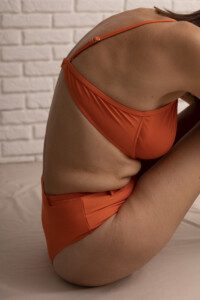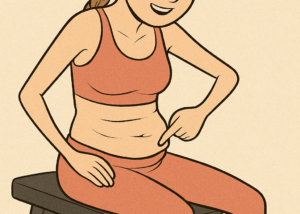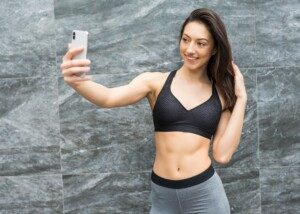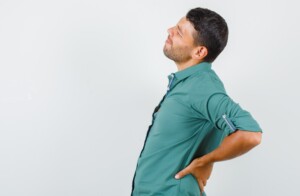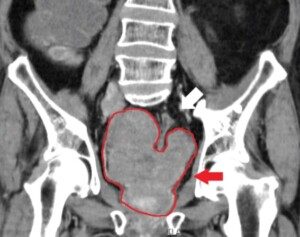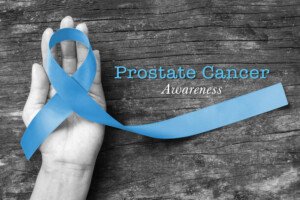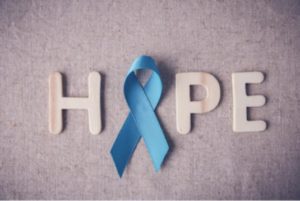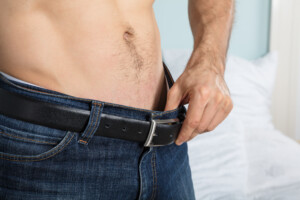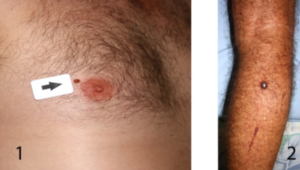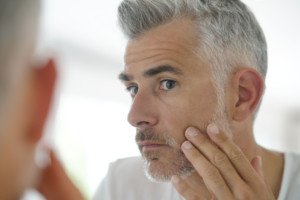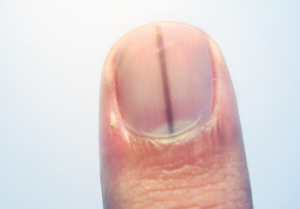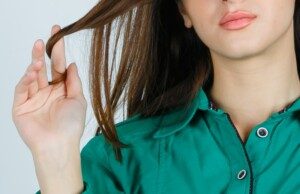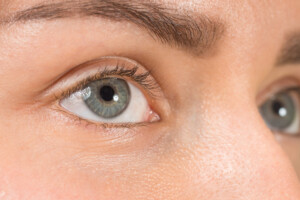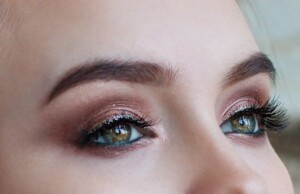It’s gotten so old: Influencers with “beauty standard” bodies posing unrealistically to look imperfect.
Why do followers eat this up? When will it stop?
Is there some kind of mysterious pressure that body-positive influencers with conventionally attractive bodies feel to present themselves in an imperfect or “flawed” way?
- Do they feel guilty for having the “after” body that so many women seek?
- Do they feel guilt-ridden for looking better than the majority of their female fan base?
- Or … are there several other reasons why this trend sees no end?
Distorting Their Body to Look Flawed
Some of these intentional, very conscious poses are ridiculous.
Many of their poses are far from natural. For example, who naturally stands with their stomach puffed out as much as possible? This is uncomfortable.
Nobody does this unless they want to show people how big they could make their tummy.
This effort contradicts the message of “every woman’s body has imperfections when she stands or sits naturally.”
Julianna’s TikTok has her tugging at the underside of her upper arm, to show thousands of viewers that even she, with her conventionally attractive body, can produce “bat wings.”
This absurdity, however, gets praised by many followers. I won’t apologize for not getting this ludicrous trend – even though I’ll also admit that these kinds of posts garner new followers all the time.
Even a competitive physique athlete with a very low, pre-contest body fat percentage could tug hard enough to show a pseudo-bat wing!
No, Julianna, you do NOT have true bat wings. It’s like you’re mocking those who actually do, due to one of the following reasons:
1) Excess flab from lack of exercise, 2) Excess skin from intentional or non-intentional weight loss, 3) Excess body fat, and 4) Low muscle tone due to a genetic disorder.
Never mind that your video got a bunch of praise; I’ll bet my life savings it also offended many women in the just-noted categories.
To get firm, toned upper arms, all Julianna and similar influencers need do is not tug!
If only all those other women had this luxury!
And for the record, I’m not jealous of her upper arms, as I’ve been lifting weights since high school and have mighty firm, strong looking arms.
My beef centers around the absurdity of this trend.
It’s bad enough when they pose in an unnatural way to create the illusion that their body has faulty areas – such as sitting in an awkward position to bring out the pseudo-stomach rolls or dimpling in the lateral upper thighs.
But it’s a whole new, deranged level to GRAB at one’s body to produce “flaws”!
In the same TikTok video, Julianna grabs at her waist, then squeezes the tissue between her fingers and thumb, to produce an unsightly compression of mini-rolls.
Of course there’s fat in these artificially created little rolls! Below everyone’s skin is subcutaneous fat.
To show what appears to be a surplus, Jul must twist funny, then grab and squash with her hand.
And the comments just flummox me; her die-hard fans think she just delivered a revolutionary message. Oh good God.
And Julianna isn’t alone with this trending fad among thinner influencers. There are many others who do the same thing.
They are lauded as body-confidence, body-image and body-positivity pioneers.
This has angered obese and plus-size influencers (such as Raffela Mancuso) who’ve worked hard to get recognition, but know all too well that the bulk of the lauding has gone to these smaller influencers with their conventionally attractive bodies who can eradicate the flaw with an instant change of position or a release of that squeezing hand.
More Relatable?
Could these slender or straight-size influencers, who often claim to have significant body-image insecurities, be making these posts to seem more authentic and relatable to their audience?
Possibly. But this can be a confusing and unhealthy cycle, in which influencers feel the need to present a version of themselves that’s both curated and “imperfect,” which may still contribute to unrealistic beauty standards.
Seeking Validation from Strangers

Slim and straight-size influencers such as Julianna may also be desperately seeking validation from followers – validation fixes to combat their ongoing body insecurities.
There’s also the argument that the message of such influencers — whom some thick and fat women claim take up way too much space in the body-positivity community — is still vitally important because their message showcases that even women with conventionally attractive bodies can still have insecurities.
And I’ll get back to that intriguing premise shortly.
The Instagram Look
Some influencers in the fitness, beauty and travel spheres edit or manipulate their photos to achieve the “perfect” look.
Julianna and others want women to know this. But what I find puzzling is that … well, why don’t women and even teens who spend a lot of time on Instagram and TikTok already know this?
How can anyone NOT know that those glorious Instagram images are carefully rehearsed and plotted, and that only the best out of many images taken make it to posting? How does a viewer not know this?
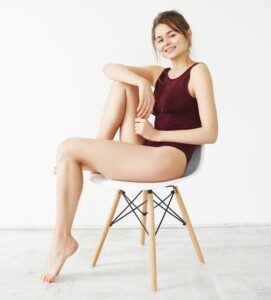
Thighs spread when against a surface. Didn’t know that? What, we’re made of wood? Freepik
When I was growing up, long before the advent of Instagram and TikTok, nobody had to teach me that when people get their pictures taken, they pose for them.
I grew up hearing the word “pose” when it came to picture-taking time.
I’d hear “smile!” all the time. I once heard a relative announce, as everyone was gathering to get a photo taken, “Let’s see some teeth!”
It was almost all about presenting yourself in a make-believe manner (e.g., a person who was feeling crummy had the biggest smile in that family picture).
Anyone who grew up or spent young adulthood during the era of “old-fashioned” cameras knows that posing was a thing.
I’d always hear statements like, “Wait a second, let me get my hair just right,” or, “Don’t shoot yet; let me tuck in my tummy,” or, “Let me get the right position,” or, “Let me first figure out what to do with my legs.”
- Nobody batted an eye about any of this.
- These pre-photo adjustments were par for the course.
- Nobody suffered any mental trauma.
- After the pictures were taken, everyone moved on; life went on as though nothing had happened.
Nowadays, heaven absolute forbid if you’re caught holding in your stomach or sitting at the edge of a seat to avoid thigh spread.
Yet the influencers who criticize posing one’s body to look as flattering as possible will stop at nothing to make sure they have two pounds of makeup on before their picture is taken!
Or, their hair has to be just right, flat on top and draped in front of both shoulders with the waves angled outward – to keep up with this fad latest hairstyle! Oh, heaven help me grasp this.
Overdoing “Imperfections”
In an attempt to push back against the images of so-called perfect bodies, some influencers will overdo their pseudo-imperfections.
They’ll show cellulite or “real” body types in an exaggerated way.
Yeah, like, I already explained that – but it can’t be pointed out enough.
The goal is to normalize “real” bodies — even though conventionally attractive influencers such as Jul don’t have the so-called real body; they have the slender “after” body that’s allegedly “unattainable for most women”!
Anyways, this goal of normalizing flawed areas of a slender or straight-size woman’s body can still set up a kind of pressure to meet another ideal — this time the ideal of looking “imperfect” or “flawed” in a way that’s still socially acceptable! Holy cow!
This Instagram and TikTok craze of both highlighting imperfections (many of which are exaggerated by unrealistic body positioning or hands-on manipulation of the body) while still presenting a highly polished image (whether perfect or imperfect) can be part of a larger issue of body image distortion that continues to affect mental health and self-esteem. Okay, reread that. Take your time.
Now, back to this premise that even women with conventionally stunning bodies can still have body insecurities.
“I can’t stop thinking about little insecurities.”
It’s absolutely true that a woman with a body to be envied could still have insecurities about her body.
Body insecurity is understandable if a woman is obese, especially 100+ pounds overweight.
There’s rhyme and reason to this unhappiness with her overall body or an area of her body that carries much of the excess fat — because fatness is not attractive and interferes with stamina and mobility.
As one ages, obesity becomes increasingly relevant to health issues; it’s no longer a matter of aesthetics once the chronic pain, acid reflux, type 2 diabetes, high blood pressure, sleep apnea and other ailments start kicking in.
So yes, there’s a lot of logic behind feeling insecure about having obesity.
But the logic is completely absent when a woman suffers from body insecurity despite a body that objectively meets the criteria for the standard of attractiveness. For instance, in Julianna’s case, she’s tall, slender and toned.
But she struggles with accepting her body — even years after the struggle began. What the hey.
- Julianna admits to the struggling.
- She’s not alone; many influencers with sought-after body types struggle with insecurities about appearance.
This makes no sense. No logic, no rhyme, no reason. And no, it’s way too simplistic to chalk all of this up to diet culture or seeing a parade of 120 pound, 5’11 Victoria’s Secret Angels on a runway.
Nor was she and many similar influencers ever in a sport where pressure to be thin was high.
So all of this makes me wonder if these slim and normal-size body image crusaders have deeper psychological issues, unrelated to body image – that have been masquerading as body-image related because these women are too fearful of confronting the REAL problem – whatever that may be — such as a domineering, overly-critical parent.
- The psychological term for this masquerading is displacement.
- And the controlling, overbearing parent doesn’t necessarily make comments about their child’s weight or body.
- The haranguing from the parent could be about anything.
Displacement means redirecting emotions or impulses related to or caused by a threatening, intimidating source (likely a parent) to a less threatening one. This happens subconsciously.
The displacement can lead to them internally crying, “If my thighs were only thinner, I’d have more friends!” even though they’re not a single pound overweight.
I myself have never, ever, ever once believed that if I were thinner, I’d have more friends.
My case is particularly intriguing because, unlike all the influencers, I’ve never even had any real friends; I’m on the Spectrum (late adult diagnosis).
I’d always blamed my personality. Now, you may think this is really sad. But — at least I wasn’t delusional, believing that a ballerina body would make me popular with my classmates!
In Julianna’s case, and the case of many other smaller influencers, the displacement makes their body become the less threatening source of their troubles.
It’s easier to fight back at the number on the scale and the width of their thighs than at a forceful, intimidating parent.
It’s easier to blame weight loss ads, Victoria’s Secret, thigh gaps, washboard abs, diet culture — and turn it into an influencer empire.
“I’m so much more than my body.”
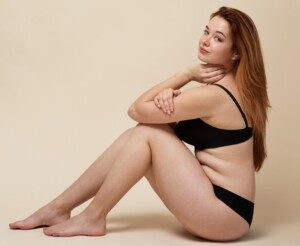
Freepik
Really? You’d never know by the incessant posting you do with your body in hardly any clothes, twisting and turning it to accentuate perceived flaws, and positioning it in ways to make it appear you have more fat than you actually do.
You so-called body positive influencers actually DO make it all about your bodies.
It’s time you think about what messages you’re really sending to vulnerable and younger followers.
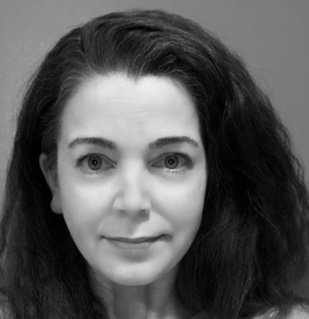 Lorra Garrick is a former personal trainer certified by the American Council on Exercise. At Bally Total Fitness, where she was also a group fitness instructor, she trained clients of all ages and abilities for fat loss and maintaining it, muscle and strength building, fitness, and improved cardiovascular and overall health.
Lorra Garrick is a former personal trainer certified by the American Council on Exercise. At Bally Total Fitness, where she was also a group fitness instructor, she trained clients of all ages and abilities for fat loss and maintaining it, muscle and strength building, fitness, and improved cardiovascular and overall health.
.

